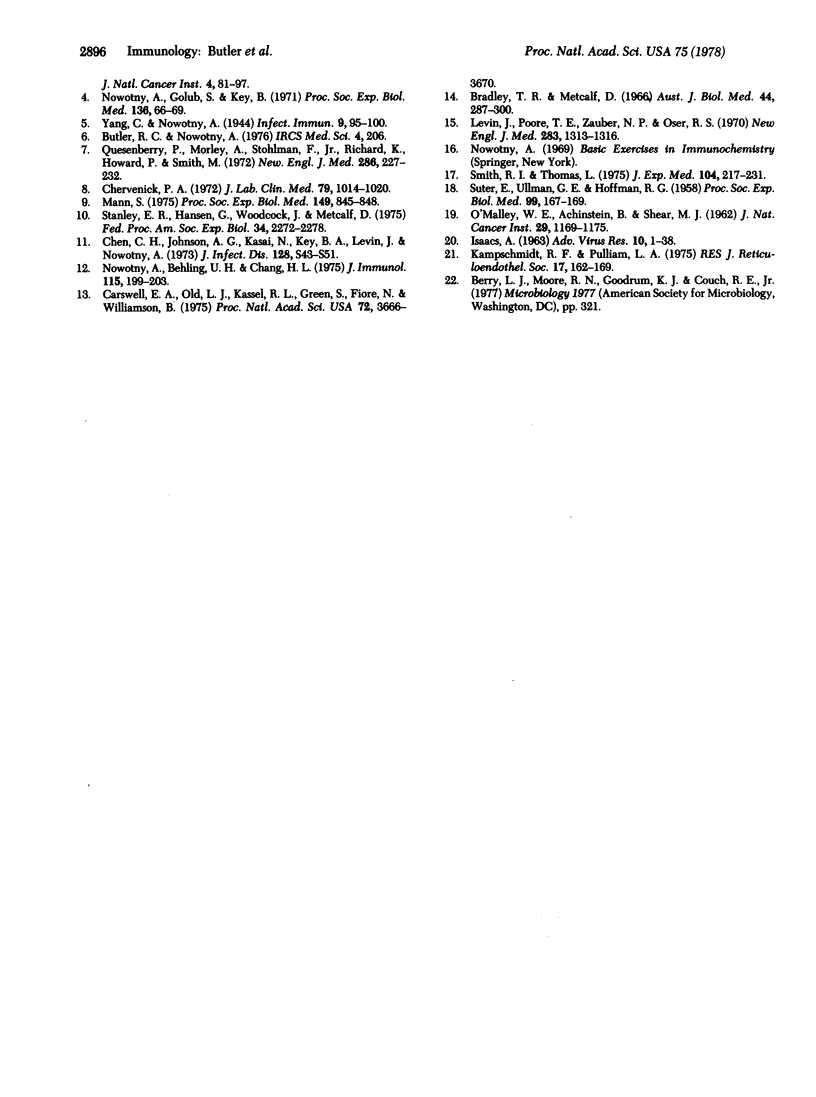Abstract
The passive transfer of postendotoxin mouse serum could enhance nonspecific resistance to the development of TA3-Ha transplantable ascites tumor in mice. The postendotoxin serum was not directly cytotoxic to TA3-Ha tumor cells in vitro, nor did it contain significant amounts of residual endotoxin, but it was rich in colony-stimulating factors (CSFs). High-titer CSF serum could be induced by endotoxic lipopolysaccharide (LPS). Nonendotoxic, lipid-free, and polysaccharide-rich hydrolytic breakdown product of LPS (called PS) was less potent but still active in CSF induction. There was a correlation between the level of CSF stimulation and the capacity of the sera to transfer tumor resistance (TUR). Those LPS preparations that had the highest CSF-inducing capacity were the most potent in TUR enhancement. Suppression of CSF production by treatment with theophylline or epinephrine, enhancers of cyclic AMP/cyclic GMP ratios, lowered the enhancement of TUR by endotoxic LPS. The infection of serum donor mice with bacillus Calmette-Guérin (BCG) 18 days prior to LPS treatment gave the highest serum CSF levels and the most potent TUR-inducing serum preparation. Even more notable was the finding that the nontoxic PS preparation could replace toxic LPS in the above BCG-LPS system. The serum harvested from BCG-infected mice 2 hr after PS injection was similarly effective in the passive transfer of TUR.
Keywords: TA3-Ha ascites tumor, passive transfer, lipopolysaccharide, tumor-necrotizing factor, anti-tumor resistance
Full text
PDF



Selected References
These references are in PubMed. This may not be the complete list of references from this article.
- Bradley T. R., Metcalf D. The growth of mouse bone marrow cells in vitro. Aust J Exp Biol Med Sci. 1966 Jun;44(3):287–299. doi: 10.1038/icb.1966.28. [DOI] [PubMed] [Google Scholar]
- Carswell E. A., Old L. J., Kassel R. L., Green S., Fiore N., Williamson B. An endotoxin-induced serum factor that causes necrosis of tumors. Proc Natl Acad Sci U S A. 1975 Sep;72(9):3666–3670. doi: 10.1073/pnas.72.9.3666. [DOI] [PMC free article] [PubMed] [Google Scholar]
- Chervenick P. A. Effect of endotoxin and postendotoxin plasma on in vitro granulopoiesis. J Lab Clin Med. 1972 Jun;79(6):1014–1020. [PubMed] [Google Scholar]
- Golde D. W., Cline M. J. Endotoxin-induced release of colony-stimulating activity in man. Proc Soc Exp Biol Med. 1975 Sep;149(4):845–848. doi: 10.3181/00379727-149-38911. [DOI] [PubMed] [Google Scholar]
- ISAACS A. INTERFERON. Adv Virus Res. 1963;10:1–38. [PubMed] [Google Scholar]
- Kampschmidt R. F., Pulliam L. A. Stimulation of antimicrobial activity in the rat with leukocytic endogenous mediator. J Reticuloendothel Soc. 1975 Mar;17(3):162–169. [PubMed] [Google Scholar]
- Levin J., Poore T. E., Zauber N. P., Oser R. S. Detection of endotoxin in the blood of patients with sepsis due to gran-negative bacteria. N Engl J Med. 1970 Dec 10;283(24):1313–1316. doi: 10.1056/NEJM197012102832404. [DOI] [PubMed] [Google Scholar]
- Nowotny A., Behling U. H., Chang H. L. Relation of structure to function in bacterial endotoxins. VIII. Biological activities in a polysaccharide-rich fraction. J Immunol. 1975 Jul;115(1):199–203. [PubMed] [Google Scholar]
- Nowotny A., Golub S., Key B. Fate and effect of endotoxin derivtives in tumor-bearing mice. Proc Soc Exp Biol Med. 1971 Jan;136(1):66–69. doi: 10.3181/00379727-136-35194. [DOI] [PubMed] [Google Scholar]
- Quesenberry P., Morley A., Stohlman F., Jr, Rickard K., Howard D., Smith M. Effect of endotoxin on granulopoiesis and colony-stimulating factor. N Engl J Med. 1972 Feb 3;286(5):227–232. doi: 10.1056/NEJM197202032860502. [DOI] [PubMed] [Google Scholar]
- SMITH R. T., THOMAS L. The lethal effect of endotoxins on the chick embryo. J Exp Med. 1956 Aug 1;104(2):217–231. doi: 10.1084/jem.104.2.217. [DOI] [PMC free article] [PubMed] [Google Scholar]
- SUTER E., ULLMAN G. E., HOFFMAN R. G. Sensitivity of mice to endotoxin after vaccination with BCG (Bacillus Calmette-Guérin). Proc Soc Exp Biol Med. 1958 Oct;99(1):167–169. doi: 10.3181/00379727-99-24282. [DOI] [PubMed] [Google Scholar]
- Seligman S. J. In vitro susceptibility of methicillin-resistant Staphylococcus aureus to sulfamethoxazole and trimethoprim. J Infect Dis. 1973 Nov;128(Suppl):543–p. doi: 10.1093/infdis/128.supplement_3.s543. [DOI] [PubMed] [Google Scholar]
- Stanley E. R., Hansen G., Woodcock J., Metcalf D. Colony stimulating factor and the regulation of granulopoiesis and macrophage production. Fed Proc. 1975 Dec;34(13):2272–2278. [PubMed] [Google Scholar]
- Yang C., Nowotny A. Effect of endotoxin on tumor resistance in mice. Infect Immun. 1974 Jan;9(1):95–100. doi: 10.1128/iai.9.1.95-100.1974. [DOI] [PMC free article] [PubMed] [Google Scholar]


